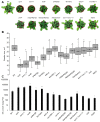"Salicylic Acid Mutant Collection" as a Tool to Explore the Role of Salicylic Acid in Regulation of Plant Growth under a Changing Environment
- PMID: 31861218
- PMCID: PMC6941003
- DOI: 10.3390/ijms20246365
"Salicylic Acid Mutant Collection" as a Tool to Explore the Role of Salicylic Acid in Regulation of Plant Growth under a Changing Environment
Abstract
The phytohormone salicylic acid (SA) has a crucial role in plant physiology. Its role is best described in the context of plant response to pathogen attack. During infection, SA is rapidly accumulated throughout the green tissues and is important for both local and systemic defences. However, some genetic/metabolic variations can also result in SA overaccumulation in plants, even in basal conditions. To date, more than forty Arabidopsis thaliana mutants have been described as having enhanced endogenous SA levels or constitutively activated SA signalling pathways. In this study, we established a collection of mutants containing different SA levels due to diverse genetic modifications and distinct gene functions. We chose prototypic SA-overaccumulators (SA-OAs), such as bon1-1, but also "non-typical" ones such as exo70b1-1; the selection of OA is accompanied by their crosses with SA-deficient lines. Here, we extensively studied the plant development and SA level/signalling under various growth conditions in soil and in vitro, and showed a strong negative correlation between rosette size, SA content and PR1/ICS1 transcript signature. SA-OAs (namely cpr5, acd6, bon1-1, fah1/fah2 and pi4kβ1β2) had bigger rosettes under high light conditions, whereas WT plants did not. Our data provide new insights clarifying a link between SA and plant behaviour under environmental stresses. The presented SA mutant collection is thus a suitable tool to shed light on the mechanisms underlying trade-offs between growth and defence in plants.
Keywords: Arabidopsis mutants; Salicylic acid; gene transcription; growth; light.
Conflict of interest statement
The authors declare that there is no conflict of interest.
Figures




Similar articles
-
Constitutive salicylic acid accumulation in pi4kIIIβ1β2 Arabidopsis plants stunts rosette but not root growth.New Phytol. 2014 Aug;203(3):805-16. doi: 10.1111/nph.12822. Epub 2014 Apr 24. New Phytol. 2014. PMID: 24758581
-
The Arabidopsis hrl1 mutation reveals novel overlapping roles for salicylic acid, jasmonic acid and ethylene signalling in cell death and defence against pathogens.Plant J. 2002 May;30(4):467-80. doi: 10.1046/j.1365-313x.2002.01300.x. Plant J. 2002. PMID: 12028576
-
Auxin promotes susceptibility to Pseudomonas syringae via a mechanism independent of suppression of salicylic acid-mediated defenses.Plant J. 2013 Jun;74(5):746-54. doi: 10.1111/tpj.12157. Epub 2013 Mar 25. Plant J. 2013. PMID: 23521356
-
Signaling Crosstalk between Salicylic Acid and Ethylene/Jasmonate in Plant Defense: Do We Understand What They Are Whispering?Int J Mol Sci. 2019 Feb 4;20(3):671. doi: 10.3390/ijms20030671. Int J Mol Sci. 2019. PMID: 30720746 Free PMC article. Review.
-
Salicylic acid beyond defence: its role in plant growth and development.J Exp Bot. 2011 Jun;62(10):3321-38. doi: 10.1093/jxb/err031. Epub 2011 Feb 28. J Exp Bot. 2011. PMID: 21357767 Review.
Cited by
-
The Two Classes of Ceramide Synthases Play Different Roles in Plant Immunity and Cell Death.Front Plant Sci. 2022 Apr 7;13:824585. doi: 10.3389/fpls.2022.824585. eCollection 2022. Front Plant Sci. 2022. PMID: 35463421 Free PMC article.
-
An Arabidopsis mutant deficient in phosphatidylinositol-4-phosphate kinases ß1 and ß2 displays altered auxin-related responses in roots.Sci Rep. 2022 Apr 28;12(1):6947. doi: 10.1038/s41598-022-10458-8. Sci Rep. 2022. PMID: 35484296 Free PMC article.
-
Salicylic Acid Signalling in Plants.Int J Mol Sci. 2020 Apr 10;21(7):2655. doi: 10.3390/ijms21072655. Int J Mol Sci. 2020. PMID: 32290350 Free PMC article.
-
Deficiencies in cluster-2 ALA lipid flippases result in salicylic acid-dependent growth reductions.Physiol Plant. 2024 Mar-Apr;176(2):e14228. doi: 10.1111/ppl.14228. Physiol Plant. 2024. PMID: 38413387 Free PMC article.
-
ACCELERATED CELL DEATH 6 Acts on Natural Leaf Senescence and Nitrogen Fluxes in Arabidopsis.Front Plant Sci. 2021 Jan 7;11:611170. doi: 10.3389/fpls.2020.611170. eCollection 2020. Front Plant Sci. 2021. PMID: 33488657 Free PMC article.
References
-
- Bravo R.E., Chen G., Grosser K., Dam N.M.V., Leiss K.A., Klinkhamer P.G.L. Ultraviolet radiation enhances salicylic acid-mediated defense signaling and resistance to Pseudomonas syringae DC3000 in a jasmonic acid-deficient tomato mutant. Plant Signal. Behav. 2019;14:e1581560. doi: 10.1080/15592324.2019.1581560. - DOI - PMC - PubMed
MeSH terms
Substances
Grants and funding
LinkOut - more resources
Full Text Sources
Molecular Biology Databases

